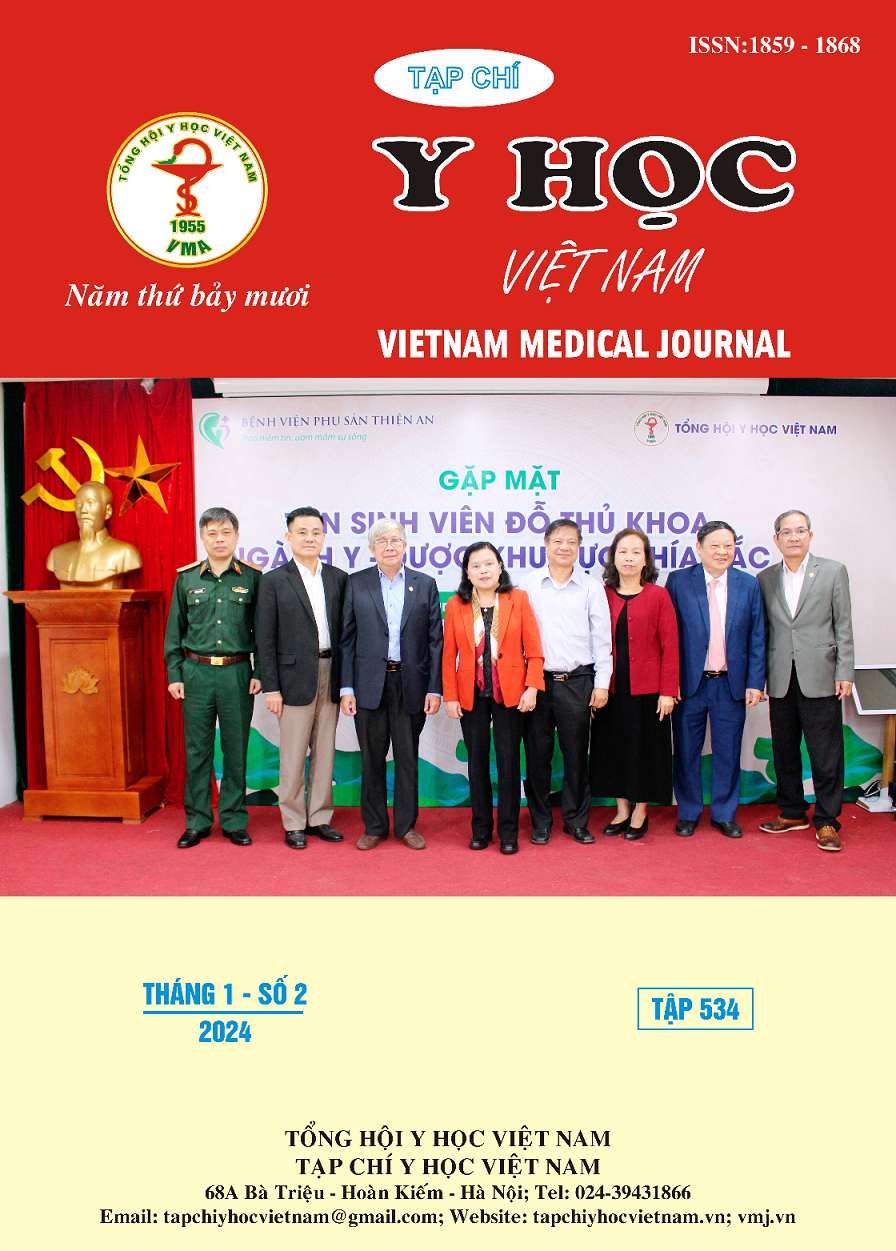INVESTIGATION OF THE VALUE OF SINUS WALL BONE LESIONS ON COMPUTED TOMOGRAPHY IN THE DIAGNOSIS OF FUNGAL SINUSITIS
Main Article Content
Abstract
Purposes: The aims of this study was to investigate the value of sinus wall bone lesions on computed tomography in diagnosing fungal sinusitis. Material and methods: Descriptive study on 70 rhinosinusitis patients examined at Hanoi Medical University Hospital from January 2022 to July 2023. These patients were all underwent a sinus computed tomography scanner, then endoscopic sinus surgery and diagnosis confirmed by post-operative fungal testing. Results: The average age was 53±11.8, the lowest age was 30 years old, the highest age was 78. Fungal sinusitis was diagnosed in 60/70 patients, accounting for 86%, of which 46/60 patients were sinus mycosis, accounting for 76.7%, the remainder are chronic invasive fungal sinusitis. On CT scan, there were 58/60 patients with sinus wall bone thickening in the fungal sinusitis group, accounting for 96.7% and 7/10 patients with non fungal sinusitis, accounting for 70%, the difference was statistically significant with p=0.02. Regarding sinus wall bone erosion, there were 4/60 patients with fungal sinusitis, accounting for 6.7% but not in the non fungal sinusitis group, the difference was not statistically significant. In the fungal sinusitis group, sinus wall bone thickening lesions were found in 44/46 patients with sinus mycosis, accounting for 95.7%, and in 14/14 patients with chronic invasive fungal sinusitis, accounting for 100%. However, osteolytic lesions of the sinus wall were only seen in 3/46 patients with sinus mycosis (6.5%) and 1/14 patients with chronic invasive fungal sinusitis (7.1%). Compared with post-operative fungal testing, the sensitivity, the specificity, the accuracy diagnosis, the positive predictive value, the negative predictive value of sinus wall bone thickening sign in the diagnosis of fungal sinusitis were Sn=96.7%; Sp=30%; ACC=87.1%, PPV=89.2%, NPV=60%, respectively. The sensitivity and specificity of sinus wall bone erosion sign due to fungal sinusitis were 100%. Conclusion: Sinus wall bone lesion was more common seen in fungal sinusitis than in non fungal sinusitis. This sign on CT scan had the high value for fungal sinusitis diagnosis.
Article Details
References
2. Hsiao CH, Li SY, Wang JL, Liu CM. Clinicopathologic and immunohistochemical characteristics of fungal sinusitis. J Formos Med Assoc Taiwan Yi Zhi. 2005;104(8):549-556.
3. deShazo RD, O’Brien M, Chapin K, Soto-Aguilar M, Gardner L, Swain R. A new classification and diagnostic criteria for invasive fungal sinusitis. Arch Otolaryngol Head Neck Surg. 1997;123(11):1181-1188.
4. Aribandi M, McCoy VA, Bazan C. Imaging features of invasive and noninvasive fungal sinusitis: a review. Radiogr Rev Publ Radiol Soc N Am Inc. 2007;27(5):1283-1296.
5. Lê Trung Nguyên. Nghiên Cứu Tình Hình Viêm Xoang Do Nấm Tại BV TMH TP. Hồ Chí Minh Từ Năm 2020-2021. Luận văn thạc sỹ y học. Đại học Y dược TP Hồ Chí Minh; 2021.
6. Mai Quang Hoàn. Khảo Sát Đặc Điểm Lâm Sàng, Cận Lâm Sàng và Điều Trị Viêm Xoang Do Nấm Tại Bệnh Viện Chợ Rẫy. Luận văn thạc sỹ y học. Đại học Y dược TP Hồ Chí Minh; 2018.
7. Trần Nam Khang. Đánh Giá Kết Quả Điều Trị Viêm Xoang Do Nấm Bằng Phương Pháp Phẫu Thuật Nội Soi Tại Bệnh Viện TMH TP. Hồ Chí Minh. Đại học Y dược TP Hồ Chí Minh; 2018.
8. Jiang RS, Huang WC, Liang KL. Characteristics of Sinus Fungus Ball: A Unique Form of Rhinosinusitis. Clin Med Insights Ear Nose Throat. 2018;11:1179550618792254.
9. Dufour X, Kauffmann-Lacroix C, Ferrie JC, Goujon JM, Rodier MH, Klossek JM. Paranasal sinus fungus ball: epidemiology, clinical features and diagnosis. A retrospective analysis of 173 cases from a single medical center in France, 1989–2002. Med Mycol. 2006;44(1):61-67.


